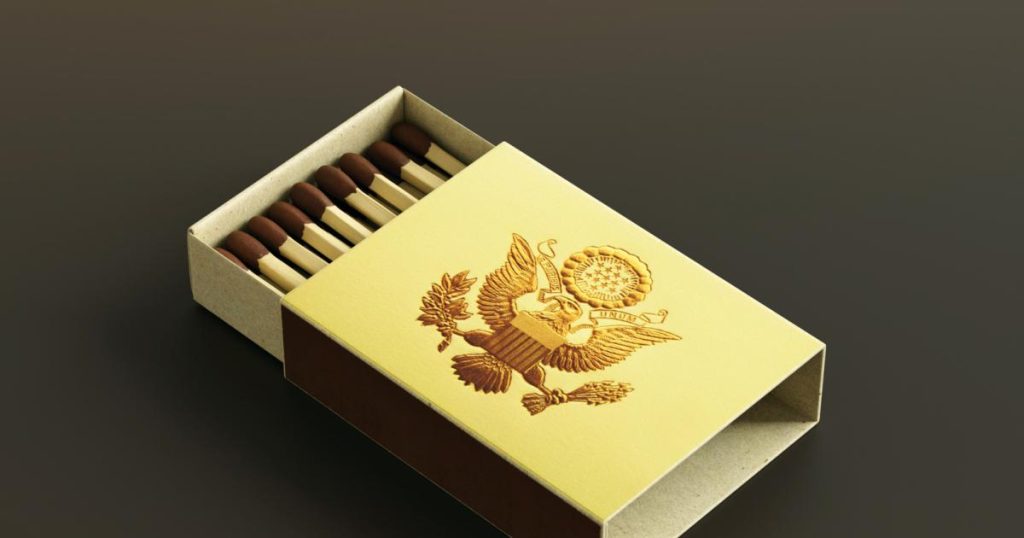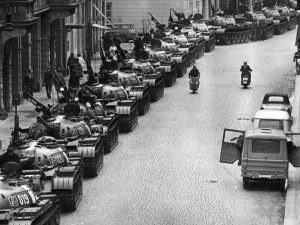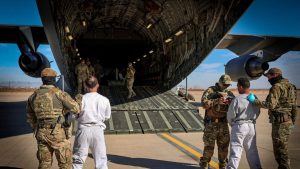Donald Trump has already transformed the American political order. Not since Ronald Reagan has a president so dominated the national landscape or shifted its ideological terrain. In his second term, Trump could reshape global order in ways no less profound.
Today’s reigning, U.S.-led international system—call it Pax Americana, the liberal order, or the rules-based international order—arose from a brutal Eurasian century. The great global struggles of the modern era were contests to rule the Eurasian supercontinent. They inflicted horrific damage on humanity. They also created the most successful international order the world has ever known. That system has provided generations of great-power peace, prosperity, and democratic supremacy. It has bestowed pervasive, world-changing benefits that are now taken for granted. After the West’s victory in the Cold War, Washington sought to make that order global and permanent. Now, however, a fourth battle for Eurasia is raging, and the system is being menaced on every front.
All around Eurasia’s vibrant, vital periphery, revisionist states are on the move. China, Iran, North Korea, and Russia are attacking the regional foundations of Eurasian stability. They are forging alliances based on hostility to a liberal system that threatens illiberal rulers and inhibits their neoimperial dreams. War or the threat of war has become pervasive. The norms of a peaceful, prosperous world are under assault. The recurring terror of the last century was that Eurasian aggressors might make the world unfit for freedom by making it safe for predation and tyranny. That danger has flared anew today.
Trump isn’t the ideal defender of an imperiled American order. Indeed, one suspects he hardly thinks about international order at all. Trump is a hard-line nationalist who pursues power, profit, and unilateral advantage. He thinks in zero-sum terms and believes the United States has long been made a sucker by the entire world. Yet Trump intuitively understands something that many liberal internationalists forget: order flows from power and can hardly be preserved without it.
In Trump’s first term, that insight helped the United States begin a messy adjustment to the realities of a rivalrous age. In his second term, it could inform a foreign policy that—by squeezing adversaries as well as allies—bolsters the free world’s defenses for the fateful fights ahead. The world has long passed the point at which American leaders can aspire to globalize the liberal order. But Trump could succeed at today’s more limited and more vital undertaking: upholding a balance of power that preserves that order’s essential achievements against Eurasian aggressors determined to tear them down.
The problem is that this will require Trump to consistently channel his best geopolitical instincts when he will be sorely tempted to follow his most destructive ones instead. If he follows this destructive path, the United States will become less globally engaged but more aggressive, unilateral, and illiberal. It won’t be an absent superpower but a renegade one—a country that stokes global chaos and helps its enemies break the U.S.-led system. Trump’s presidency offers an opportunity to steer Washington toward a stronger, if less sweeping, defense of its global interests. Yet it also presents a grave danger: that Trump will take the United States not into isolationism but into something far more lethal to the world his forebears built.
CYCLES OF CONFLICT
Eurasia has long been the crucial theater of global politics. The sprawling landmass holds most of the earth’s people, economic resources, and military potential. It touches all four oceans, which carry goods and armies around the world. An empire that ruled Eurasia would have unmatched power; it could batter or intimidate the most distant foes. Three times in the modern era, the world has been convulsed by fights over the supercontinent and the waters around it.
In World War I, Germany sought a European empire stretching from the English Channel to the Caucasus. In World War II, a fascist alliance ran roughshod over Europe and maritime Asia and invaded the Eurasian interiors of China and the Soviet Union. In the Cold War, the Soviet Union assembled an empire of influence that stretched from Potsdam to Pyongyang and waged a decades-long struggle to overthrow the capitalist world.
Eurasian conflicts shattered continents and confronted humanity with the risk of atomic annihilation. Yet they also created opportunities for order. In the world wars, transoceanic coalitions turned back Eurasian aggressors, forging patterns of cooperation that brought the United States into the Old World’s strategic affairs. In the Cold War, Washington—twice burned by Eurasian conflagrations—opted to keep the supercontinent from combusting again.
The enemies of the liberal order have reclaimed the initiative.
American alliances deterred aggression against Eurasia’s industrially dynamic margins—Western Europe and East Asia—while also smothering old tensions within them. A U.S.-led international economy muted the autarkic, radicalizing impulses of the pre–World War II era. Washington cultivated a Western community in which democracy survived, thrived, and later spread to other regions. Only unprecedented investments by the overseas superpower could break the cycle of Eurasian conflict. The payoffs were historic advances—the avoidance, since 1945, of global war and global depression; the ascendancy of democratic values; seas made safe for trade and states made safe from death by conquest—that would have seemed impossible just decades before.
During the Cold War, the achievements of this order—then confined to the West—helped defeat the Soviet Union. In the unipolar era that followed, Washington tried to take its system global. The United States preserved and even expanded its Eurasian alliances as sources of influence and stability. It promoted democracy and markets in eastern Europe and other regions, trying to co-opt potential challenges by showing that people there could flourish in Washington’s world. Over time, the thinking went, this three-part package of U.S. hegemony, political convergence, and economic integration would foster a deep, enduring peace across Eurasia and beyond.
This post–Cold War project probably prevented an earlier, faster reversion to global rivalry. It made the world freer, richer, and more humane. But lasting Eurasian peace remained elusive. To illiberal states that sought to build or rebuild their own empires, the liberal order looked not enticing but oppressive. China and Russia used the prosperity that the U.S.-led system fostered to bankroll renewed geopolitical challenges. And American overreach in Afghanistan and Iraq left the United States poorly situated to resist the resulting threats during a critical decade. Today, a new geopolitical era is unfolding. The enemies of the liberal order have reclaimed the initiative, and Eurasia is once again the site of vicious struggles.
REVISIONISTS’ BALL
Every crucial corner of Eurasia is alight with coercion and conflict. In Europe, Russia’s war against Ukraine is also a war to rebuild a post-Soviet empire and fracture the existing security order. The covert counterpart of that war is a campaign of subversion spanning the continent, as the Kremlin conducts sabotage and political destabilization operations meant to punish its European foes. In the Middle East, Iran and its proxies have been battling Israel, the United States, and their Arab allies while Tehran has crept closer to the nuclear weapons it believes will indemnify its regime and ensure its regional primacy. In Northeast Asia, North Korea is improving its nuclear arsenal and long-range missiles, and it means to use the resulting leverage to sever the U.S.–South Korean alliance and bring the peninsula under its control. China, for its part, is bent on global power. For now, it is bullying its neighbors as part of a bid for a hulking sphere of influence—“Asia for Asians,” Chinese leader Xi Jinping calls it—and readying for war in the western Pacific by conducting one of the biggest military buildups in modern history.
From eastern Europe to East Asia, revisionist powers are seeking dramatic changes in the global balance of power. They are also trying to wreck the liberal order by smashing its most crucial norms. Russian President Vladimir Putin is reasserting the principle that strong states can swallow weaker neighbors. China’s revanchist claims and maritime coercion in the South China Sea are meant to show that big countries can simply grab the global commons. Putin’s quasi-genocidal barbarities in Ukraine and Xi’s industrial-scale repression in Xinjiang threaten to restore a world of autocratic impunity and rampant atrocity. The Houthis, a Yemeni militia backed by Iran, have created their own fundamental challenge to freedom of navigation, using drones and missiles to attack shipping in the Red Sea.
Each revisionist power seeks an environment conducive to repression and predation. Each understands it can best achieve its aims if the American order is laid low. The world is undergoing changes “the likes of which we haven’t seen for 100 years,” Xi told Putin in 2023—and the revisionists are pursuing those changes together.

China and Russia are linked in a “no limits” partnership that features ever-deeper economic, technological, and military cooperation. Iran and Russia have an expanding relationship that includes the exchange of weapons, technology, and expertise in how to evade Western sanctions. North Korea and Russia have sealed a full-blown military alliance and are fighting together against Ukraine. These ties don’t yet add up to a single, multilateral alliance. U.S. officials sometimes dismiss them as proof of Russia’s isolation and desperation amid its war in Ukraine. But the relationships are part of a thickening web of ties among the world’s most dangerous states, and they are already inflicting serious strategic harm.
Autocratic alliances intensify challenges to the existing order. Putin’s war in Ukraine, for example, has been sustained by the arms, troops, and trade he gets from his illiberal friends. A dictators’ peace within Eurasia also raises the risk of conflict around its margins. Putin can focus on Ukraine and Xi can more aggressively probe American power in maritime Asia because the two leaders know that their long, shared border is secure. These alliances are also changing regional military balances by giving Putin the arms he needs in Ukraine and by giving Putin’s partners the Russian weapons, technology, and know-how to accelerate their own buildups. Perhaps most alarming, these relationships fuse Eurasian crises.
Ukraine’s war has become a global proxy war, pitting the advanced democracies that support Kyiv against the Eurasian autocracies that back Moscow. And as autocratic alignments cohere, Washington must face the prospect that a war that starts in one region could spill over into others—and that the next country the United States fights could receive aid from its autocratic friends. In the meantime, the multiplicity of Eurasian problems overtaxes American resources and creates an atmosphere of pervasive, proliferating disarray. The strategic nightmare of the twentieth century—that Eurasian aggressors might combine forces to upend the global order—has been revived in the twenty-first.
HOLLOW VICTORIES
Trump is not the obvious man for this moment—in some ways, it’s hard to imagine anyone worse suited to it. He originally rode to power on a blistering critique of American globalism. He spent his first term tormenting allies and threatening to withdraw from trade deals and defense pacts that serve as pillars of the U.S.-led world order. His illiberal, even insurrectionary tendencies made him a model for would-be strongmen from Brazil to Hungary. If analysts have obsessed over the state of the liberal order during the Trump era, it is because he often seems set on throwing it all away.
Trump certainly lacks admiration for the liberal order’s achievements and sympathy for its basic ethos. His “America first” agenda holds that the world’s mightiest power has been systematically exploited by the system it created and that a country that has long shouldered unique global burdens has no obligation to pursue anything but its own self-interest, narrowly construed. He has little interest in the flourishing of liberal values overseas. Moreover, Trump has no respect for the orthodoxies of his predecessors, including their belief in the geopolitically soothing effects of globalization or their tendency to treat alliances as sacred obligations. Throughout Trump’s first term, his disdain for these traditions drove committed internationalists to despair and produced corrosive uncertainty within the democratic world. But Trump’s instincts also helped him spot accumulating problems in the post–Cold War project and initiate some needed adjustments.
First, Trump recognized that globalization had gone too far. Welcoming autocratic states—China, in particular—into the world economy had not made them members of a global community or primed them for political evolution. Instead, it had entrenched dictators and empowered them to challenge the United States. Whatever its economic merits, globalization created strategic vulnerabilities, such as Europe’s dependence on Russian energy and the democratic world’s entanglement with Chinese telecommunications firms. Trump recognized that defending American interests would require limiting and even reversing global integration—especially with countries on the other side of the widening geopolitical divide.
A sharp-elbowed superpower might not be the worst thing right now.
Trump also saw that the post–Cold War defense paradigm—in which U.S. allies disarmed and relied ever more heavily on a unipolar superpower—was out of date. That approach worked in the 1990s, when tensions were low and many analysts feared that U.S. allies, such as Germany and Japan, might rise again as threats. Instead, autocratic rivals reemerged and rearmed. Trump’s first term thus saw sustained, sometimes humiliating pressure on allies to raise defense spending, along with efforts to pivot the Pentagon away from counterterrorism and counterinsurgency and toward great-power threats.
Most fundamentally, Trump concluded that the ascendancy of the liberal order was over and the world of cutthroat power politics was back. Washington would henceforth demand more from its friends because it faced growing dangers from its enemies. The United States would have to wield its influence more aggressively against countries trying to reshape the system to their advantage—including through a “maximum pressure” campaign against Iran and strategic competition with China. It might have to downgrade democratic values to cultivate motley balancing coalitions, such as anti-Chinese alliances in the Indo-Pacific and stronger Arab-Israeli cooperation against Iran. In sum, Washington should focus less on the positive-sum project of globalizing the liberal order and more on the zero-sum imperative of stopping determined adversaries from imposing their own, antithetical visions of how the world should work.
Unfortunately, Trump never got as much as he could have out of these insights, because his good ideas were always at war with his bad ideas and because his administration was always at war with itself. His policies were often incomplete, inconsistent, or contradictory. His record during his first term was highly ambiguous: Trump damaged and derided the American order but also protected it from its excesses and its enemies. In the higher-stakes environment of his second term, he has a chance to be the ambivalent savior of that system—if he can resist the temptation to be its gravedigger.
REBALANCING ACT
One thing is certain: Trump will not become a lover of the liberal order. His geopolitical inclinations have not changed, and his antidemocratic tendencies have only gotten worse. His “America first” platform still features a stark, omnidirectional nationalism aimed at friends, enemies, and everyone in between. Yet given the state of the world, a sharp-elbowed superpower might not be the worst thing right now. If Trump can harness his more constructive impulses, he has a chance to pressure adversaries, coax more out of allies, and reinforce resistance to the Eurasian assault. More fundamentally, he has an opportunity to rightsize the U.S. approach to international order—to complete the shift to an era in which the United States isn’t expanding the liberal project but simply preventing its achievements from being destroyed.
Step one would be a major military buildup. The international order is sagging because the military balance of power is sagging. The Pentagon doesn’t have the resources to thrash Iran’s proxies while also countering China; it struggles to both arm Ukraine and support Taiwan. The United States probably could not buy enough military power to face all its rivals simultaneously. But if Trump’s “peace through strength” program took U.S. spending from just over three percent to around four percent of GDP, it could ease crippling munitions shortfalls and narrow the gap between Washington’s commitments and its capabilities. This would also require significantly more military spending by U.S. allies, which Trump—who might really kick free riders to the curb—could probably get.
Thus, a second initiative: tougher bargains with allies. Trump is wrong if he thinks that Washington doesn’t need alliances. But he is right that imperiled allies need them even more. There is an opportunity here to renegotiate existing security pacts. If frontline Asian democracies expect the United States to potentially fight World War III against China, they should make outlays commensurate with the existential threat they perceive. Likewise, the price for Trump’s commitment to NATO might be a European pledge to spend dramatically more—say, 3.5 percent of GDP—on defense, buy U.S. weapons to support Ukraine, and align with American tech and trade controls vis-à-vis Beijing. The process of renegotiating the transatlantic compact could be ugly. But the payoff would strengthen the alliance against two Eurasian threats.
Of course, Europe will not be stable without a decent peace in Ukraine. Trump’s promise to end that war quickly and cleanly is unrealistic. He might fail to end it at all. But his desire to do so does coincide with the imperative of preventing Ukraine from losing and the autocratic axis from winning a war that is gradually, but unmistakably, going in the wrong direction. In the near term, this will require accelerating the crisis facing Putin’s war effort by ramping up sanctions on Russia’s energy sector and its trade with China while delaying an equivalent crisis in Kyiv by conditioning continued support on fuller mobilization of Ukraine’s military-age population. In the longer term, Washington will need to fashion security guarantees for Ukraine that foreground European initiative but feature a credible American backstop.

Meanwhile, Trump could challenge the Eurasian axis by squeezing its weakest link. In recent months, Israel has brightened a grim geopolitical landscape by battering Iran and its proxies. Trump could increase the strain through aggressive sanctions and threats of fresh military action, whether U.S. or Israeli, against Tehran and what remains of its “axis of resistance.” The goal would be to bolster Middle Eastern stability by imposing new curbs on Iran’s nuclear program and limiting its capacity for sowing regional chaos. If Trump simultaneously compelled a vulnerable Iran to stop sending Putin drones and missiles—or simply revealed the limits of Moscow’s support for Tehran in a crisis—he might start the long, difficult process of straining the revisionist entente.
Trump could also craft a sharper China strategy by building on Biden-era policies that, in turn, built on Trump’s own first-term initiatives. Beijing’s belligerence should help the Pentagon keep stitching together tighter security relationships—and perhaps establish more military basing opportunities—in the Indo-Pacific. Higher U.S. and allied defense spending and larger weapons sales to Taiwan could slow the erosion of Washington’s military advantage. Harsher technology controls and tariffs could compound China’s economic crisis—if Trump doesn’t trade them away for a deal to sell Beijing more soybeans. Trump won’t win the struggle between Washington and Beijing, but he might strengthen the U.S. position for the long contest ahead.
Finally, Trump should seek to exploit escalation rather than avoid it. From Ukraine to the Middle East, the Biden administration painstakingly calibrated and telegraphed its moves to avoid escalatory spirals. Minimizing that risk sometimes allowed U.S. adversaries to predict and even dictate the tempo of these interactions. Trump, for his part, prizes unpredictability. If he showed, however, that he would cross new thresholds with little warning—by sanctioning Chinese banks that are facilitating Putin’s war or striking Iran in response to Houthi attacks in the Red Sea—he could force U.S. adversaries to contemplate uncontrolled escalation with the world’s strongest power.
All this would amount to an ambivalent defense of the liberal order. Trump might still engage in gratuitous protectionism and pick pointless diplomatic squabbles. But he could nevertheless achieve something essential: shoring up the strategic bargains and geopolitical barriers that keep the enemies of the U.S.-led order from breaking through.
REFORM OR REVOLUTION?
This agenda could stumble on its own contradictions: Trump will struggle to boost military spending, cut taxes, and slash the deficit all at once. Likewise, it will be hard to rally U.S. allies against China while pummeling them with protectionist measures. Trump could also falter because a world of ambitious, colluding autocracies is difficult even for the most skillful superpower to handle. Most fundamentally, Trump might fail because he is more of a wrecking ball than an architect—and he may take American policy down a darker course.
The most crucial question about Trump has always been whether he means to reform or revolutionize U.S. foreign policy. In his first term, the answer was usually closer to reform than revolution, thanks to the moderating influence of advisers and Republican allies and also because Trump—who delights in extorting diplomatic ransoms—hesitated to shoot the hostage by tearing up the North American Free Trade Agreement or leaving NATO. Yet Trump did, by all accounts, seriously consider pulling the trigger. His “America first” slogan is straight out of the 1930s. So if the optimistic scenario is that a president focused on posterity keeps reforming U.S. strategy for a viciously competitive era, the pessimistic scenario is that a president who now rules his party and administration will unleash the revolution with a purer, more radical version of “America first.”
This latter scenario would not mean a return to isolationism, since there is no such American tradition. Before World War I, the United States wasn’t a Eurasian stabilizer, but it was a hemispheric hegemon with a long, sometimes bloody record of territorial expansion. Today, a nastier version of “America first” would be lethal to the liberal order not just because the United States would say goodbye to Eurasian security commitments but because it would become more predatory and illiberal to boot.
The outlines of this agenda are not a mystery; Trump talks about them all the time. He has long mused about quitting NATO and other alliances, which bother him precisely because they tie the fate of the United States—history’s most physically secure country—to obscure disputes in distant regions. If U.S. allies cannot or will not hit higher spending targets, perhaps because Trump makes his demands too extreme, he might finally obtain his pretext to bring the legions home.
Trump is more of a wrecking ball than an architect.
Likewise, if Trump tires of the travails of peacemaking in Ukraine, he might just walk away from that conflict and leave the Europeans to deal with the mess. If he sees Taiwan primarily as a high-tech rival, not a crucial security partner, he might slash U.S. support in exchange for economic benefits from Beijing. The United States would still maintain a mighty military, no doubt, but it would be one that is focused on fighting cartels in the New World rather than containing expansionists in the Old World. In the near term, this approach would insulate the United States from Eurasian quarrels and produce “wins” in trade concessions and dollars saved. Over time, however, it would dramatically raise the odds of key regions plunging into chaos or falling under the sway of aggressive states.
Rival powers might still suffer under this agenda. If Trump imposes the extreme 60 percent tariffs that he has threatened, he will hammer China’s export-dependent economy. If he wields tariffs mercilessly as tools of leverage, he will surely squeeze some concessions out of allies and adversaries alike. Yet harm to economic competitors might be outweighed by self-harm to the American system. Aggressive protectionism would reduce the collective prosperity that has long held the democratic world together and kill the cohesion needed to check a mercantilist China. Similarly, if Trump uses tariffs and sanctions, rather than global leadership and security commitments, to bolster the dollar’s primacy, he might make Washington look just as exploitative as the countries whose ambitions it means to thwart.
Meanwhile, the United States wouldn’t simply be de-emphasizing liberal norms and values; it would be casting a long, illiberal shadow. If Trump shutters hostile media outlets or turns the military or law enforcement agencies against his enemies, he will weaken American democracy while offering political cover, and a playbook, to every aspiring autocrat who wishes to attack a free society from within. Trump might also set back democratic values by coercing Ukraine into a lousy peace or supporting Hungarian President Viktor Orban and other rulers who seek to dismantle European liberalism. The balance of ideas reflects the balance of power. The democratic recession of recent years could become a rout if Washington quits the fight for the world’s ideological future—or, worse still, joins the other side.
Indeed, this version of “America first” wouldn’t just clear the way for Eurasia’s revisionists; it could well aid their cause. The revisionists aim to create an environment primed for expansion and plunder. Perhaps Trump gets along so well with Putin and Xi because he wants the same thing. Trump has said that the United States must annex Greenland, make Canada the 51st state, and reclaim the Panama Canal. He seems to envision a world in which strong states and strong rulers can do more or less as they like. Maybe this is all clever diplomacy—or mere trolling. But the further Trump takes this expansionist agenda, the more he risks alienating Washington’s closest allies and abetting the autocrats’ spheres-of-influence game.
These possibilities constitute a nightmare scenario for those who rely on the American order, but nightmares don’t always come true. Such a radical reengineering of U.S. strategy would face resistance from Democrats and some Republicans in Congress, and from the bureaucratic and international inertia that generations of American engagement have fostered. Stock markets would not react well to a protectionist onslaught. Yet the disquieting fact remains that a country with an extremely powerful executive branch has twice elected a president who seems deeply attracted to a slash-and-burn approach. Imagining an illiberal, renegade United States is only a matter of taking seriously what Trump says. The greatest risk of his second term, then, is not that he will abandon the liberal order. It is that he will make the United States actively complicit in its demise.
WHICH WAY IS UP?
The potential upside of Trump’s presidency is substantial. The potential downside is an abyss. The existence of such extreme possibilities is a source of international instability in its own right. It is also a testament to the double-edged nature of the hard-line nationalism Trump represents. If applied with discipline and a constructive spirit, such an approach could plausibly help the United States hold the Eurasian aggressors at bay. In a more extreme, unmoderated form, it could prove fatal to a system that requires a broad view of U.S. interests, a commitment to liberal values, and an ability to wield unmatched power with the right blend of assertiveness and restraint.
Here, unfortunately, lies the real problem with the optimistic framing: it requires assuming that Trump, a man who assiduously nurses his personal and geopolitical grievances, will discover—at the very moment he feels most empowered—the best, most globally minded and most diplomatically savvy version of himself. All those in the United States and elsewhere with a stake in the survival of the liberal order should hope that Trump rises to this challenge. But they should probably brace for the prospect that Trump’s world could become a very dark place.
Loading…








